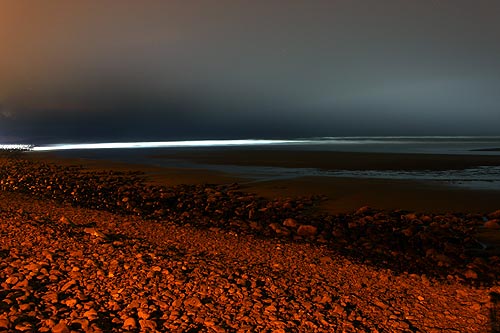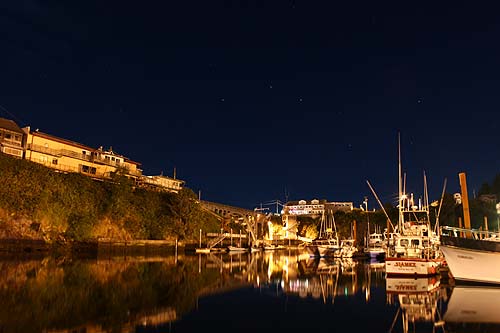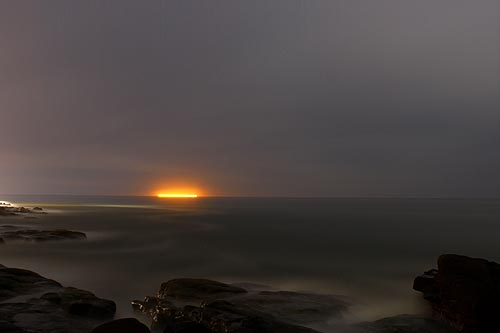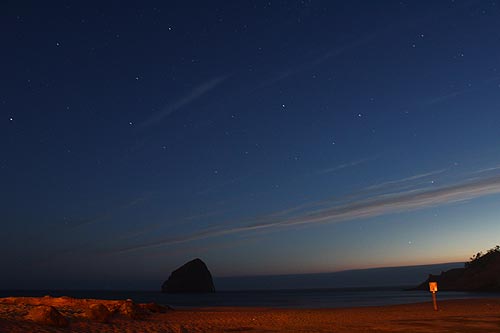 |
More Outer Space and Earthly Oddities Found on Oregon Coast Nights
Published 08/17/2013

(Oregon Coast) – Nights on the Oregon coast continue to get more interesting, and we're not talking about those oddballs bars along these beaches. If meteor showers still happening right now aren't enough, or the possibilities of glowing sand or seeing a space station overhead, you can now add an explosion way out there in the galaxy to the list of oddities. (Above: Cannon Beach at night).
Those Perseid Meteor showers that peaked last week aren't done with yet. You can still see them until August 24, though not as many – and their frequency is decreasing.

Also still visible until August 24 is the International Space Station, which will make some gnarly flyovers on Saturday night and later this week. See the exact schedule here, but the ISS will make some pretty bright appearances tonight (Saturday night) close to 10 p.m., and then Monday and Tuesday night in and around 9 p.m. and 10 p.m. Another bright one happens on Thursday. Above: Seaside, Oregon at night.
Look up – straight up – and you may see traces of an exploding star this weekend. Scientists have discovered a new nova out there in the galaxy, and it should be visible to those in Oregon and on the Oregon coast.
It's called Nova Delphinus 2013, discovered this week on August 14 by amateur astronomer Koichi Itagaki of Yamagata, Japan. A nova is essentially a massive explosion from a star, but not the same nor as big as a supernova, which signals the end of a star. You can see photos of the new nova here.
OMSI planetarium manager Jim Todd said to find the nova you have to find the constellation of Delphinus. You will likely need binoculars, but astronomers say it may be possible to see it with the naked eye.

Depoe Bay, Oregon at night
“After sunset, first look for the three stars of the Summer Triangle, Vega, Deneb and Altair, nearly overhead.” Todd said. “The star Deneb is in the constellation of Cygnus, the Swan or also known as the Northern Cross. Below Cygnus is the tiny constellation of Delphinus, the Dolphin.”
Find the star map here.
Another fun and funky find that is a little more likely this time of year is the famed “glowing sand” phenomenon. Look for a dark beach at night and near the tide line, in the wet sand you may see tiny, greenish-bluish sparks as you rub your feet in the sand.
This is caused by little creatures called dinoflagellates, which are a form of bioluminescent phytoplankton. Scoot your feet in the sand, going backwards, and as the sand kicks up you'll see those tiny flashes of light.

Yachats, Oregon at night
It's not guaranteed – finding these is definitely hit and miss. But they are seen a bit more in the warmer months.
Weather may or may not be cooperating on the Oregon coast for the interstellar events, however. The next few nights are calling for partly cloudy to mostly cloudy skies, but the majority of days are forecast to be almost entirely sunny – so there is still plenty of hope. Below: from top to bottom: Newport at night, Oceanside at night, and Pacific City after dark. More about the Oregon coast.



More About Oregon Coast hotels, lodging.....
More About Oregon Coast Restaurants, Dining.....
LATEST Related Oregon Coast Articles
Oregon Coast, Valley and Likely Washington Coast to Get Some Aurora Borealis ... |
Back to Oregon Coast
Contact Advertise on BeachConnection.net
All Content, unless otherwise attributed, copyright BeachConnection.net Unauthorized use or publication is not permitted
Secrets of the Season |
Unusual Travel Articles TravelParanormal.com allows you to submit your own creepy tale or debunk one - or see up-to-the-minute news headlines about travel and the paranormal. News Headlines from All Over Oregon Need to scan Oregon headlines? Constantly updated news from all over Oregon: a comprehensive, up-to-the-minute display of news headlines from a variety of media |









































